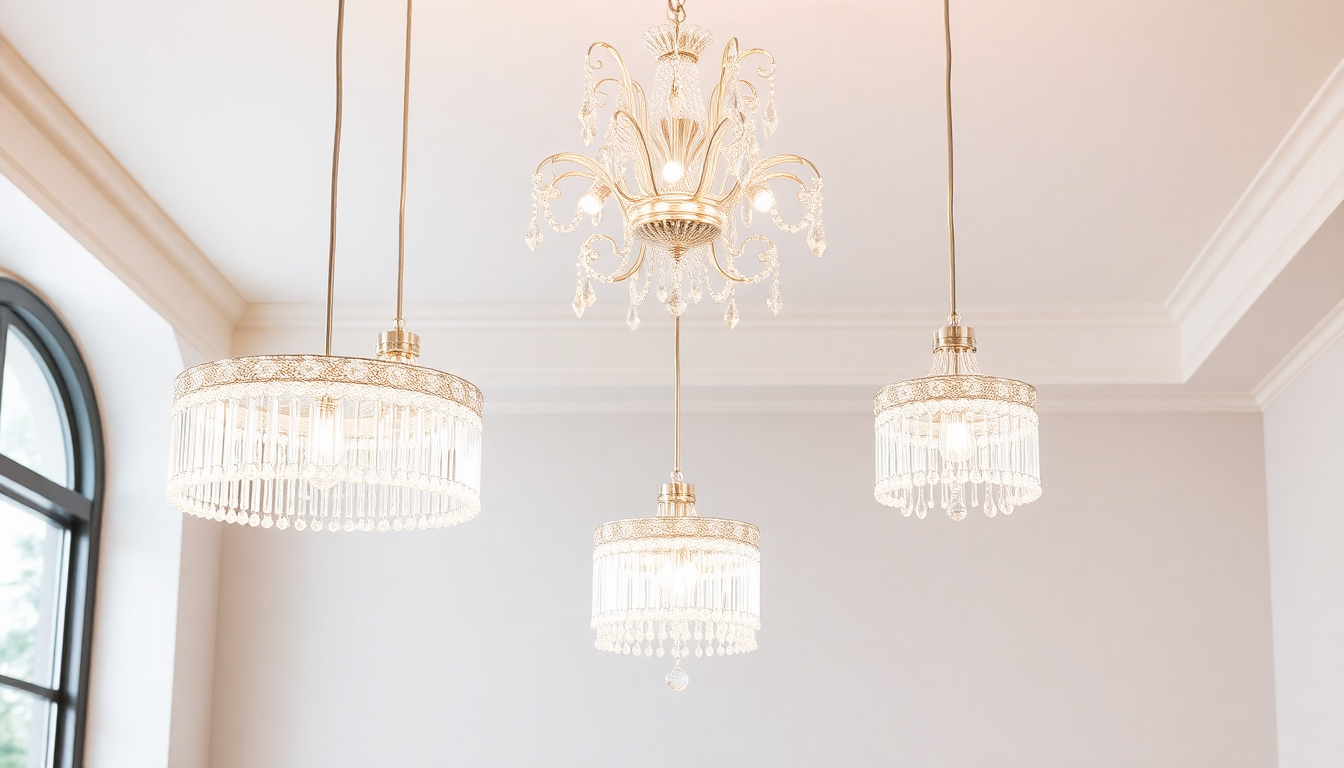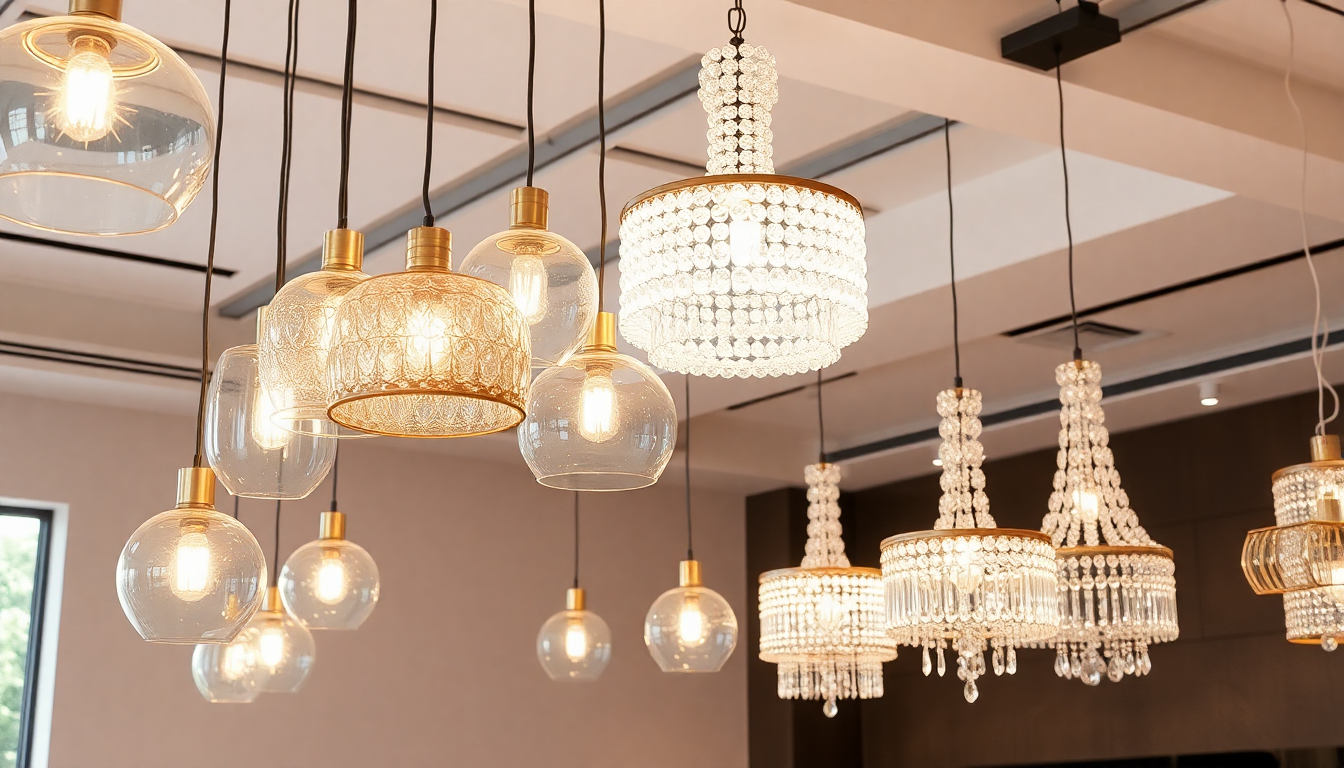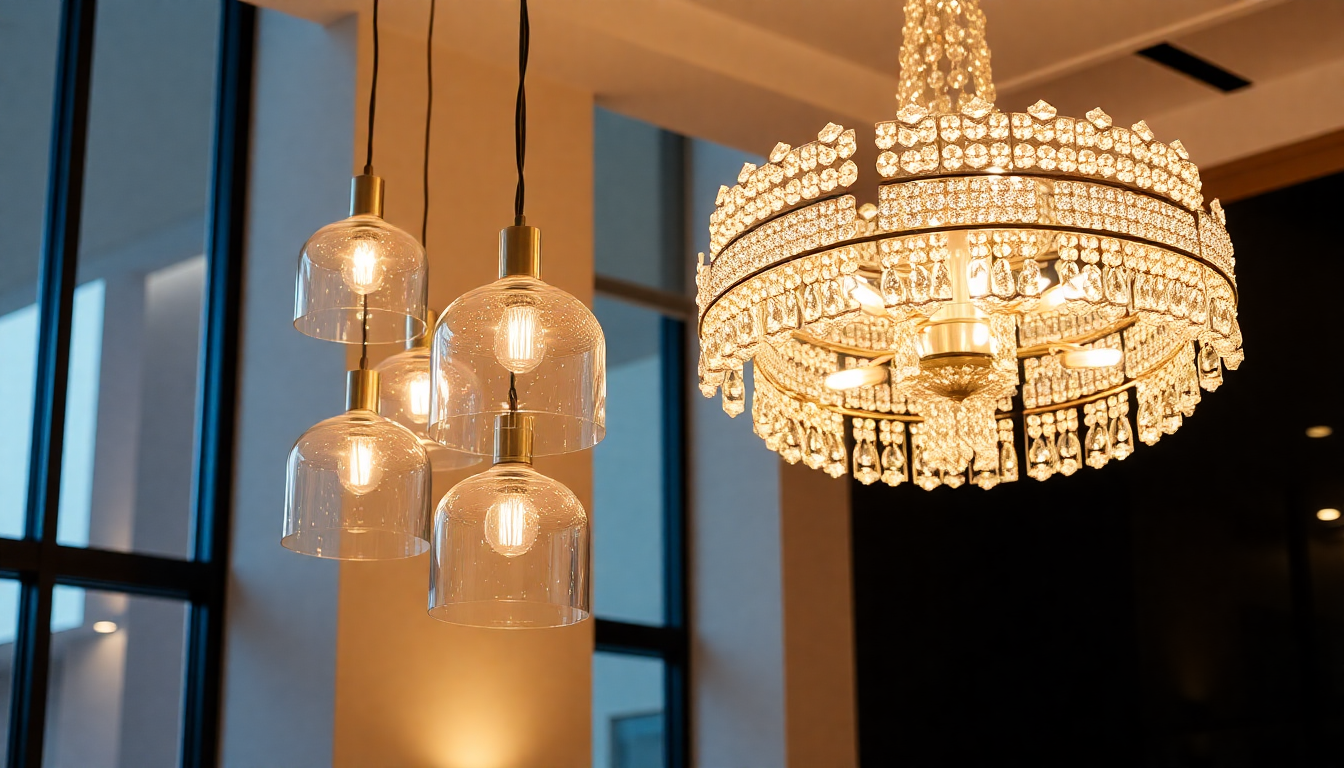Introduction: Why Lighting Decisions Matter
Lighting defines a room more than almost any other design element. The right chandelier brings scale and drama; the right glass pendant lights add task light, texture, and personality. When chosen and placed thoughtfully, a crystal chandelier paired with complementary glass pendant lighting creates a layered, dynamic interior that feels both cohesive and intentional. This extended guide helps you pick the perfect crystal chandelier, choose matching glass pendants—whether clear, milk glass pendant light, stained glass pendant light, or blown glass pendant lights—and implement them for stunning, practical results.
How to Start: Assess Your Space
Before you shop, measure and evaluate. Great lighting begins with accurate dimensions and an understanding of function.
- Measure room length, width, and ceiling height.
- Identify primary functions for each area (ambient light, task light, accent light).
- Note architectural features (coffers, beams, skylights) and traffic flow that may affect fixture placement.
- Consider electrical points and whether you'll need new drops or a junction box for a chandelier.
Right-Scale Rules: How to Choose the Perfect Chandelier for Your Space
Scale is the most common mistake. Use these reliable rules to choose a chandelier that reads correctly in the room:
- Room width + length (in feet) = ideal chandelier diameter (in inches). Example: 12 ft + 14 ft = 26 inches.
- Dining table width x 0.5–0.75 = chandelier width. For an 8-ft table (96 in), a 48–72 in chandelier may be appropriate; most dining tables work well with 1/2 to 2/3 width.
- Ceiling height matters: hang the bottom of the chandelier 30–36 inches above the dining table for 8-ft ceilings; add about 3 inches per extra foot.
- Clearance in open areas: bottom of chandelier should be at least 7 feet above finished floor for walking areas; increase height in high-traffic zones or above stairs.
For multi-level rooms, consider vertical scale. A foyer with a two-story ceiling can handle multi-tiered crystal chandeliers that would overpower a single-story dining room.
Style Matching: Choose a Crystal Chandelier That Reflects Your Room
Once scale is settled, decide style. The right crystal chandelier should echo the room’s character and other finishes.
- Traditional: multi-tier crystal chandeliers with ornate metalwork and prismatic drops.
- Transitional: simplified crystal forms combined with matte or brushed metal frames.
- Modern: geometric crystal clusters, minimal frames, or chandeliers that use crystal as a texture rather than ornament.
- Glam/Luxe: large, highly reflective crystal surfaces and polished chrome or brass finishes.
Choose a metal finish that complements existing hardware. Warm metals (brass, gold, bronze) pair with warm palettes; cool metals (nickel, chrome, black) fit modern schemes.
Complementary Glass Pendant Lighting: Principles for Pairing
A chandelier can be the hero while pendant lights support the scene. Follow these pairing principles for balance and cohesion.
- Hierarchy: Let the chandelier remain the primary focal point. Use glass pendant lights for zones that need focused illumination—kitchen islands, bedside tables, reading nooks.
- Material echo: Repeat either glass or metal elements from the chandelier in the pendants to create a visual thread.
- Contrast for interest: If the chandelier is ornate, choose simpler glass pendants (clear or milk glass). If the chandelier is minimalist, consider decorative blown glass pendant lights or a stained glass pendant light as accents.
- Match bulb temperature and dimmability to keep light color consistent between chandelier and pendants.
Glass Types Explained: Clear, Frosted, Milk Glass, Stained, and Blown
Choosing the right glass influences light quality and the room’s mood. Here’s how each glass type behaves and where it shines:
- Clear glass pendant lights: Bright, crisp light. Bulbs are visible and can be a design element (vintage filament LED). Best for task-heavy zones.
- Frosted glass: Softer, diffused light that reduces glare. Ideal for ambient fixtures and intimate spaces.
- Milk glass pendant light: Opaque and soft, milk glass provides even illumination and a vintage-modern vibe. Great for bathrooms, bedrooms, and minimalist kitchens.
- Stained glass pendant light: Colorful and decorative—use as an accent to introduce pattern and color, especially in eclectic or period interiors.
- Blown glass pendant lights: Each piece is unique. Blown glass adds organic form, texture, and subtle color variations. Wonderful for contemporary spaces seeking artisanal details.
Room-by-Room Lighting Strategies
Different rooms have different needs. Below are proven approaches for integrating a crystal chandelier with targeted glass pendant lighting.
- Entry & Foyer: Use a striking crystal chandelier as a vertical focal point. Complement with a single blown glass pendant near the door or console table for balance.
- Dining Room: Center a chandelier above the table. Consider glass pendant lights in adjacent corners, hung lower than the chandelier to create interest, or use wall sconces as supporting light.
- Kitchen: Pair a modest chandelier in an open-plan dining area with a linear trio of clear or blown glass pendant lights over the island for task lighting. Milk glass pendant light options can create softer island lighting when you want a warm, even glow.
- Living Room: A chandelier anchors the seating area; use glass pendant lights as reading lights beside sofas or as bedside pendants in open-concept studio layouts.
- Bedroom: A smaller crystal chandelier can add glamorous ambient light. Use milk glass pendant light fixtures for soft bedside illumination without the bulk of table lamps.
Design Combinations: Practical Pairing Examples
Here are concrete combos that work well together:
- Classic glam: Large tiered crystal chandelier + two clear glass pendant lights over side console tables. Keeps sparkle centerstage while adding functional light.
- Modern artisan: Minimal crystal cluster chandelier + three blown glass pendant lights of varying shapes over island. The chandelier provides ambient sparkle; the pendants add sculptural interest.
- Transitional simplicity: Simple crystal chandelier with a brushed brass frame + milk glass pendant light fixtures for a soft, cohesive look in dining and kitchen areas.
- Eclectic color pop: Vintage crystal chandelier + stained glass pendant light as an accent near a reading nook or entry bench.
Lighting Layouts: Practical Tips for Placement
- Kitchen islands: Space pendants 24–30 inches apart for a standard 8–10 ft island. Adjust spacing for island width.
- Linear island runs: Use 3 pendants for islands 6–8 ft, 4+ for longer islands; align pendants with the sink and prep areas where possible.
- Staircases & double-height spaces: Suspend a chandelier for vertical drama, then use smaller pendant clusters at landing levels for continuity.
- Bathroom vanities: Use milk glass pendant light fixtures or frosted pendants mounted to the side to avoid direct glare and build flattering light.
Bulbs, Color Temperature, and Dimmers
Choosing the right bulbs and controls ensures your fixtures look their best and perform optimally.
- Color temperature: 2700K–3000K (warm white) is ideal for living spaces and dining rooms to create an inviting atmosphere. Cooler temperatures (3500K–4000K) are useful for kitchens and task-oriented spaces.
- CRI (Color Rendering Index): Choose bulbs with CRI 90+ for accurate color rendering—especially important under glass pendants that highlight food or textiles.
- Dimmers: Use compatible dimmable LEDs and quality dimmer switches to control mood and intensity. Confirm dimmer compatibility with LED bulbs and LED drivers where applicable.
Installation & Safety Considerations
Large crystal chandeliers often require more than a simple ceiling box swap. Follow these steps for safe installation:
- Check ceiling box weight rating. If the chandelier is heavy, install an appropriate brace or junction box rated for the fixture’s weight.
- Hire a licensed electrician for new wiring runs, multi-fixture installations, or when reinforcing mounting points.
- Balance fixtures on multi-drop pendants by using a level and measuring drops accurately; stagger heights with purpose for asymmetrical looks.
- Consider accessibility for cleaning. Chandeliers in high ceilings may need lowering hardware for maintenance.
Maintenance: Keep Crystal & Glass Sparkling
Caring for crystal chandeliers and glass pendant lighting preserves their beauty and function.
- Dust weekly with a soft cloth or feather duster. For crystal, use a microfiber cloth to avoid streaks.
- Deep clean annually: Turn off power, remove bulbs, and clean crystals and glass in a mild detergent solution or a 3:1 solution of water to isopropyl alcohol. Dry thoroughly before reassembly.
- Inspect wiring and secure fasteners yearly. Replace any clouded or damaged glass elements promptly.
Budgeting & Luxury Looks on a Budget
You can achieve a luxurious look without a sky-high budget by mixing statement pieces with affordable complements.
- Invest in one higher-quality focal piece (a crystal chandelier) and select budget-friendly glass pendant lights for task areas.
- Choose pendants with glass finishes that echo the chandelier’s sparkle (clear glass) or soften its glow (milk glass pendant light) depending on the look you want.
- Look for blown glass pendant lights from smaller studios for artisan looks at moderate prices; choose fewer, larger pendants to keep costs down while achieving impact.
Product Picks & Inspiration
Below are curated product examples for inspiration. Use them to visualize combinations and to guide your shopping. Each product link includes an image so you can assess scale and finish.
-
Classic Crystal Chandelier — Elegant Tiered Design
Why it works: High-refraction crystals create a luxurious focal point for dining rooms and double-height foyers. Pair with clear glass pendant lights for task-focused areas nearby.
-
Clear Glass Pendant Light — Minimal Globe
Ideal uses: Island lighting and breakfast counters. Matches well with crystal for continuity of sparkle.
-
Milk Glass Pendant Light
Ideal uses: Soft ambient lighting in bedrooms, bathrooms, and minimalist kitchens. The milk glass pendant light offers a flattering, diffuse glow.
-
Stained Glass Pendant Light
Ideal uses: Accent lighting where color and pattern are desired—entryways, bars, or as a focal pendant beside a seating area.
-
Blown Glass Pendant Lights — Handblown Collection
Ideal uses: Contemporary kitchens and lounges. Blown glass pendant lights provide organic shapes that contrast beautifully with structured crystal forms.
-
Shop our full glass pendant lighting collection
Discover more options for glass pendant lights and glass pendant lighting to match any chandelier and style.
Case Studies: Before & After Scenarios (Inspiration)
Reading real-world scenarios helps you visualize the result. Here are two examples of successful pairings.
- Classic Renovation: A Victorian dining room with high ceilings received a large crystal chandelier centered above the table. To modernize, the homeowner added three clear glass pendant lights hung low over a newly installed sideboard for buffet lighting. The chandelier maintained period drama while the pendants added functional task light and modern contrast.
- Contemporary Remodel: An open-plan loft installed a linear crystal cluster chandelier above the living area while placing three blown glass pendant lights over the kitchen island. The blown glass shapes added warmth and handcrafted detail, while the chandelier provided overall ambient sparkle that unified the loft.
Mixing & Matching: Rules of Thumb
- Keep a unifying element—finish, glass tone, or bulb type—when mixing different pendant styles.
- Use odd numbers for groupings (3 or 5) to achieve visual balance.
- Don't match everything exactly—contrast between crystal and glass can be intentionally stylish.
Frequently Asked Questions
-
Q: Can I pair a very ornate crystal chandelier with modern glass pendants?
A: Yes—if you let the chandelier be the hero and choose pendants that are simpler in form or neutral in finish. Milk glass pendant light or clear glass pendants often work well to avoid competing with ornate crystal.
-
Q: What bulb type is best for glass pendants?
A: Dimmable LED bulbs with a warm color temperature (2700K–3000K) and high CRI are ideal. For clear glass pendant lights, filament-style LEDs look especially attractive.
-
Q: How do I ensure my chandelier is safe to hang?
A: Verify the ceiling box weight rating, consult a structural or electrical professional for heavy fixtures, and always hire a licensed electrician for hardwired installations.
Final Checklist: Ready to Buy
- Confirm room dimensions and chandelier diameter using the room rule.
- Choose a chandelier style and metal finish that complements your room.
- Select glass pendant lights (clear, milk, stained, or blown) based on function and the mood you want to create.
- Pick bulbs and dimmers for consistent light color and control.
- Hire an electrician if necessary and verify ceiling mounting and weight capacity.
Conclusion: Build Depth With Thoughtful Pairings
Right-scale, right-style lighting transforms spaces. A crystal chandelier establishes scale and luxury; complementary glass pendant lighting—whether glass pendant lights in clear or frosted finishes, a milk glass pendant light for softness, a stained glass pendant light for color, or unique blown glass pendant lights for craft—adds function and personality. By measuring carefully, choosing consistent finishes, and layering light thoughtfully, you can create interiors that are beautiful, functional, and memorable.
Ready to begin? Start with measurements, decide your focal point, and explore chandelier and glass pendant lighting collections to mix and match options that fit your budget and design goals. Happy designing!




